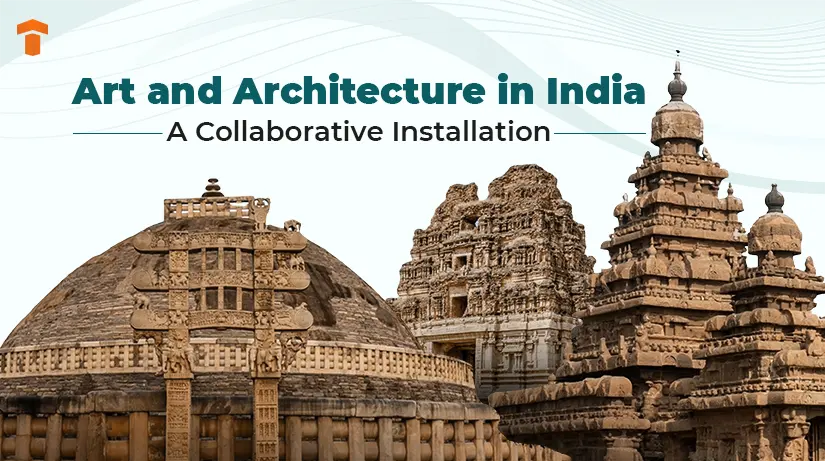Art and Architecture in India: A Collaborative Installation
Oct 23, 2024
Category: Others
Admin

Art and architecture have been intertwined with each other for thousands of years, especially in India. A discussion of architecture cannot be completed without art.
India’s love for art and architecture traces back to the second half of the third millennium BCE, when the earliest forms of Indian art emerged from the Indus Valley civilization, which are known as Harappa and Mohenjodaro.
Since then, architecture and art have covered a long way and you can recognize the heavy influence of culture, religions and regimes on them as the times progressed. In this write-up, let’s discuss how art and architecture in India transformed in different eras.
Mauryan Art and Architecture
The Mauryan empire marks a significant phase in India’s cultural history. Our country witnessed the finest pieces of architecture and art during this period spanning from around 321 BCE to 185 BCE. Distinctive sculptural and architectural styles, especially Buddhist art and architecture, thrived in this period as Mauryans were influenced by Buddhism.
Indian art progressed from wood to stone and pottery was also a significant part of art and architecture under Mauryan rule. Notable examples of Mauryan art and architecture are Stupas, Caves, Pillars, Palaces and Pottery.
During the rule of Ashoka, numerous Stupas were built in various parts of the nation. They used bricks or different sizes of stones to construct Stupas. Sanchi Stupa is well-known among them.
Pillars of this era showcase the pinnacle of architecture and art. These pillars have two parts; a capital and a shaft and they were not built to support any structure. Animal figures are carved on the capital part and the shaft gives a unique look with an exquisite polish.
Rock-cut caves are the major part of architecture and art in the Ashoka’s rule. Some of the examples of these caves are Barabar Hill in north Gaya, Sudama Caves and Nagarjuni Hill Caves.
Pallava Art and Architecture
Pallava kings had an immense interest in art and architecture. They laid the foundation of Dravidian art and building design, which reached a new level during the reign of the Chola dynasty.
Pallavas, who ruled from the 3rd century to the late 9th century, had two phases of architecture. The first one was the Rock-cut phase, in which monuments were made of pillared halls carved into mountain faces. They exhibited intricate craftmanship and resembled the Jain temples. An example of the same is a cave temple in Pallavaram.
In the next phase, Pallava architecture evolved and along with pillers, they constructed free-standing monolith shrines. These shrines are also known as rathas. One of the examples of the same is Arjuna’s Penance and Pancha Rathas at Mahabalipuram.
The 8th century brought a significant shift into the architecture of Pallavas. They began building structural designs and constructed free-standing shrines with the use of exquisite stones and mortar.
A few examples of architecture from this era are Mahabalipuram’s Shore temple and Kanchipuram’s Kanchi Kailasanathar temple.
Pallava dyansty also encouraged art such as paintings, music and sculptures. Most impressive of them are the celebrated music inscriptions of Kudumiyanmalai and Thirumayam. Many temples, such as Kailasanatha and Vaikuntha Perumal temples, have excellent mural paintings. They depict the images from Hindu mythology.
Rock-cut sculptures also mark a distinct era in Pallava art and architecture. Anatasayanam, the Mahishasurmardini in relief, Arjuna’s penance or descent of the Ganga, Gajalakshmi and Trivikrama Vishnu are the most popular sculptures from that period.
Gupta Art and Architecture
India reached a new level of excellence in art and architecture in the Gupta era. This period from 4th to 6th century is considered the golden era of Indian architecture. Their architecture and art thrived through cave paintings and temples.
Temple architecture in this period revolved around five types:
In the first type, they had square architecture and flat terraces and halls were surrounded by the pillars. These temples had a mandapa and an entrance with a garbagriha. Kankali Devi temple, Tigwa, is an example of the same.
The second type resembles the first one, however, these types of temples had a pradakshina area. One of its examples is Shiva temple in Bhumara.
A square shape and shikhara, or pyramidal roof pattern, are the major features of the third type of temple architecture in this era. The platforms of these temples were also higher. Dasavatara temple is one of its examples.
They used a hollow roof shape and rectangular pattern to build the fourth type of temples. For example, Kapoteswara temple.
In the fifth type of temple, Guptas used circular architecture. The unique shape of the four corners, which create a rectangular pattern, also stands out. An example: Maniyar Math, Rajgir.
Cave painting was also encouraged during the rule of Guptas. They crafted mural paintings on the cave walls. People used frescoes to paint the caves and showcased an amazing level of naturalism. These paintings exhibit various events from the life of Buddha.
They used red color to outline the paintings and never used blue color. Notable examples of caves from that era are: Ajanta caves, Ellora caves, Bagh caves, Udaygiri caves and Pandav caves.
Chola Art and Architecture
The Chola Kingdom ruled southern India from 9th to 13th century. Their names are etched in history for their vital contribution to the field of art and architecture. Chola rulers built many brick temples and later stone temples across their kingdom.
Chola art and architecture has an influence of Pallava style architecture. You can witness both circular and square sized sanctums in their temples. They decorated the sanctums and inner sides of the external walls. On the other hand, Cholas built carved vimanas (towering structures) on the upper part of the sanctums.
Other distinguishing features of the Chola temples are the gopurams (gateways) and mandapas (pillared halls). This empire is also known for noteworthy sculptures and ornamental works. Metal and stone sculptures are an integral part of plenty of Chola temples.
They also excelled in portrait making and the walls of Nageswaraswamy temple and Koranganatha temple are testaments to the same. The Cholas’ artworks depict religious, cultural and social values.
Here are the renowned examples of architecture from this era: Brihadeeswarar temple at Tanjore and Airavatesvara temple in Darasuram. Notable artworks from this period are Kulothunga-III and Cholamadevi in Kalahasti temple.
Vijayanagara Art and Architecture
Vijayanagara was an empire that ruled South India from 1336 to 1646 and left a lasting legacy of art and architecture. They drew inspiration from the outstanding style of architecture of the Chola, Hoysala and Chalukya empires.
The art and architecture of Vijayanagara is characterized by its highly decorated style. Intricate carvings and sculptures beautify the walls, pillars and ceilings of the structures from this period. They built many temples using granite as the primary building material. Vijayanagara rulers used soapstone for creating arts such as reliefs and sculptures.
Vijayanagara temples had Kalayana mandapas (marriage halls) with ornate pillars, massive rayagopurams (meticulously carved monumental towers at the entrences of temples) and robust fences around them. Also, the temples had life-sized statues of deities.
Their structures have an influence of courtly architecture. Vijayanagara rulers used mortar alongside other materials, which opened the ways for them to build structures that had features of Islamic architecture such as domes, arches and vaults.
They also expressed themselves through murals, frescoes and portrait-style paintings. These paintings featured motifs from Hindu cosmology, including gods and goddesses, individuals participating in cultural activities such as dancing and playing musical instruments.
The most famous architectural marvels of this era are the Lotus Mahal, Queen’s Bath, Royal Platform, Elephant Stables, Water Tanks and Virupaksha Temple.
Mughal Art and Architecture
Mughals added a new chapter to the rich history of art and architecture in India. The Mughal period, which spanned from the 16th to mid-18th century, brought an influence of Persian, Indian and Islamic styles in the architecture and art. Red sandstone and white marble, ornate carvings and intricate inlay work are its other main features.
The Mughal era architecture followed a consistent pattern in character and structure. Large onion-shaped domes, ornamental gardens and lavish courtyards were the focal points of architecture and art during the Mughal period.
Mughal structures also feature slender minarets, grand arched doorways and massive halls. They built forts, gardens, towns, mosques and mausoleums.
Major examples of architectural gems from this period are the Red Fort, Taj Mahal, Old Fort, Humayun’s Tomb, Agra Fort and Buland Darwaza.
Conclusion
Many of these structures from various eras have earned the status of a UNESCO World Heritage Site. They are standing tall and constantly reminding us of our glorious past. Furthermore, the art and architecture from these periods are still inspiring the young architects to build architectural wonders.
FAQs
Q1. What are the finest examples of architecture of the Mauryan period?
Ans. Sanchi Stupa, Ashoka Pillars and Rock-cut caves at Barabar Hills are the symbols of art and architecture from the Mauryan era. They showcase intricate carvings, polished stones and reflect a blend of Mauryan and Buddhist cultures’ influences.
Q2. What is the style of Mughal art and architecture?
Ans. Architecture and art from the Mughal period represented a blend of Indian, Persian and Central Asian influences. Their structures consist of domes, minarets, massive vaulted gateways and halls. In the art, they used detailed ornamentation, vibrant colors, geometric shapes and gold.
Q3. What was the art and architecture of Cholas?
Ans. Chola dynasty followed the Dravidian style of architecture. Their structures have multi-storyed pyramid-shaped towers known as vimanas with lofty gopurams. The interiors of these buildings have mandapas, which are the pillared assembly halls.








